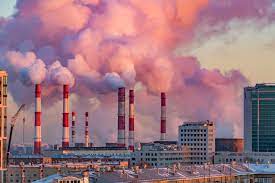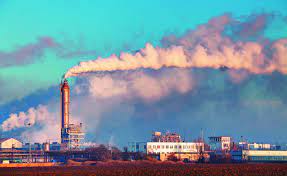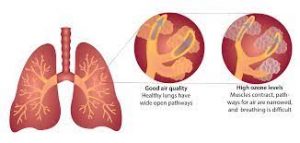Numerous studies have associated a wide range of health effects with air pollution, but as there are many different pollutants in the pollution mixture, it is rarely possible to link specific health issues to a specific pollutant. The effects detected could be a consequence of one or several air pollutants.
- Case study: London 1952
- How does air pollution affect us?
- Key Fact
- Level of health effects
- Specific causes of health effects
- Ozone
- Particulate matter
- Traffic
Case study: London 1952
 The earliest evidence that air pollution is linked with negative health effects was seen in London, UK in 1952. Several thousand people died in London as a consequence of a special weather situation. A cool layer of air got trapped below a layer of warm air, so it was unable to rise.
The earliest evidence that air pollution is linked with negative health effects was seen in London, UK in 1952. Several thousand people died in London as a consequence of a special weather situation. A cool layer of air got trapped below a layer of warm air, so it was unable to rise.
This phenomenon, known as a temperature inversion, creates a ceiling, trapping polluted air close to the ground. The temperature inversion lasted for four days in December. As the weather had been cold, the people in London had been burning large quantities of coal which formed a radiation fog across the city. Approximately 4,000 people were known to have died from the smog, and many more suffered severe breathing problems.
How does air pollution affect us?
Air pollution affects people in different ways. Factors such as current health conditions, age, lung capacity and time spent in polluted air, can all influence how pollutants affect overall health.
Large particles of air pollutants can affect the upper airways of the lungs in particular, whereas smaller particles can reach the smaller airways and the alveoli deep in the lungs.
People exposed to air pollutants could experience short-term effects or long-term effects depending on these factors. Pollution in cities has been linked to increases in emergency visits to hospitals and hospital admissions due to lung diseases, and also heart disease and stroke.
Research has previously looked at the impact of air pollution specifically on the lungs, as the gateway for pollution to enter the body. However, there is a growing amount of evidence that shows the negative effects of pollution on the heart.
The below symptoms and illnesses have all been linked to air pollution; 
- Chronic cough
- Phlegm
- Lung infections
- Lung cancer
- Heart disease
- Heart attack
Other studies have also linked traffic-related pollutants with the delayed growth of unborn babies and premature births.
Key Fact
According to a report by the European Topic Centre on Air and Climate Change (ETC/ACC) air pollution is associated with 455,000 premature deaths every year in the EU’s 27 member states.
Level of health effects
The below table shows the range of health effects that can occur and the number of people affected by these effects.

Specific causes of health effects
Health effects of pollution are likely to be caused by a range of pollutants rather than by one element, however some studies have identified specific links with both ozone and particulate matter.
Ozone
Research by experts in the USA has shown that there is a link between changes in ozone concentration and deaths during the summer.
Response to ozone depends on three different factors:
• Concentration:the higher the ozone level, the more people are affected
• Duration: the longer the exposure, the stronger the effect on the lungs
• Air volume inhaled: the more a person exerts themselves, the stronger the effect on the lungs
Symptoms include inflammation and irritation in the lungs, which could lead to other problems such as a cough or tight chest. These symptoms can disappear when exposure to ozone ends.
Particulate matter
Previous studies suggest that fine particles may play an important role in affecting lung health, as they can reach the small airways and the alveoli, which can be permanently damaged.
The fine particles also remain suspended in the air for longer periods of time and they are transported over much longer distances. They are also more likely to move directly from the lungs to the blood and other parts of the body, which could possibly impact on the heart.
Traffic
Exhaust pollutants can reach very high levels along busy roads, with the most extreme conditions found in narrow streets with tall buildings. People walking, playing or living close to main streets have a greater risk of developing health problems, especially during busy commuter periods.
This is particularly true for the development of asthma. A large body of evidence has confirmed that traffic-related pollutants contribute to the development of childhood asthma, at least among children who are genetically susceptible.
